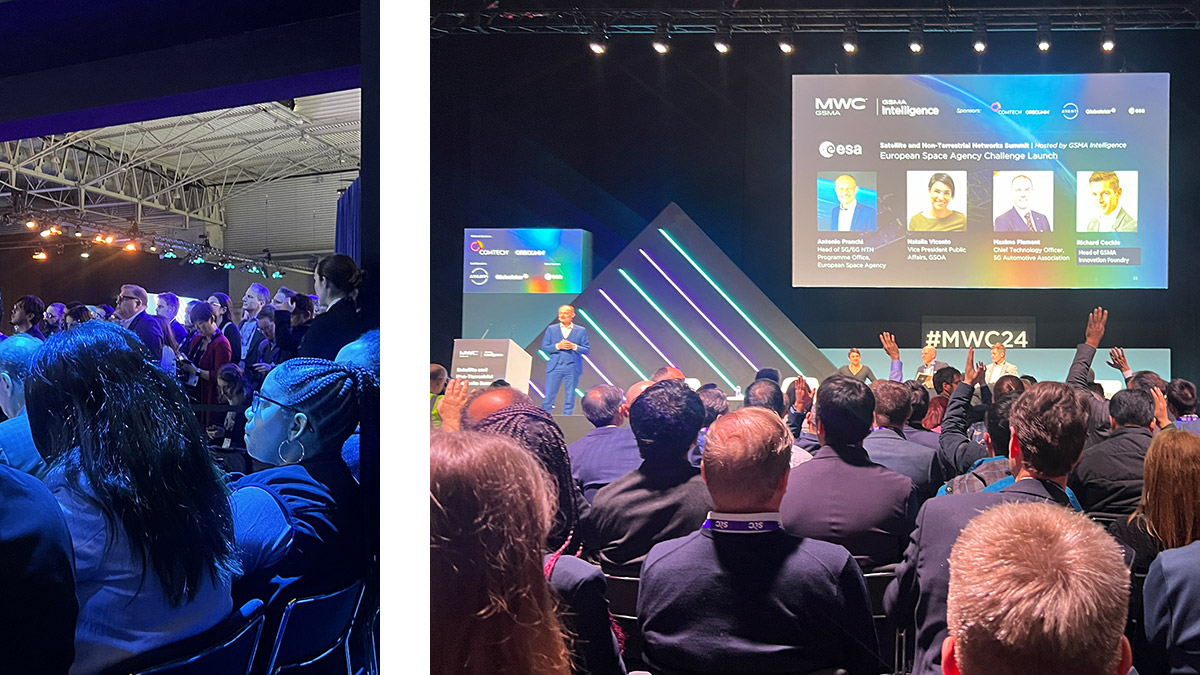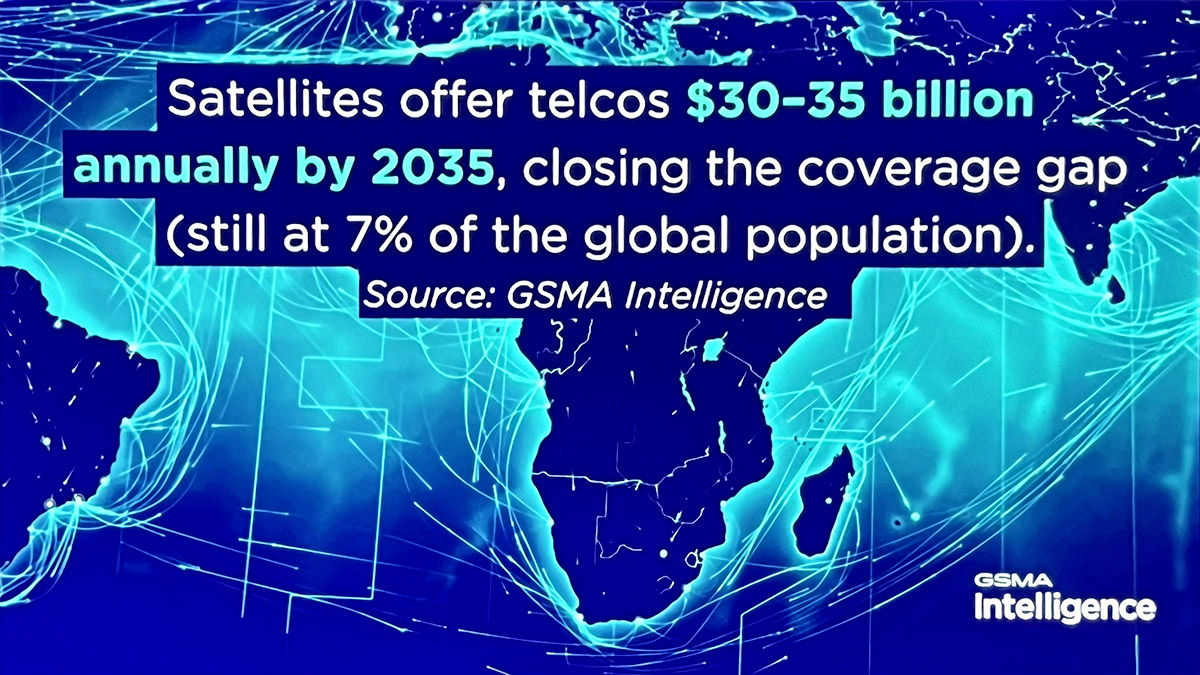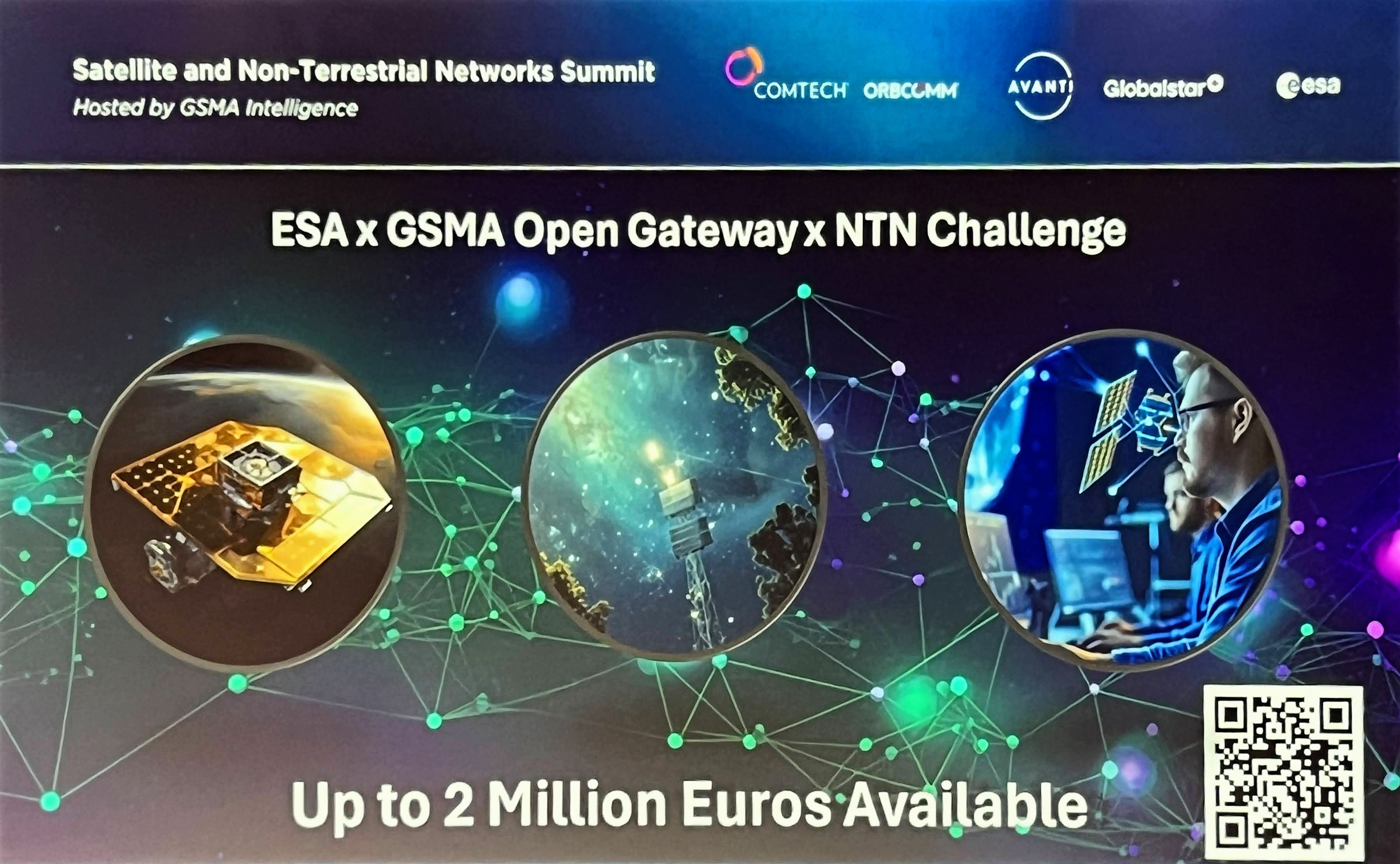Photo Gallery (Source: Kassie Carley/Kratos)
BARCELONA — Satellite has had a growing presence at Mobile World Congress (MWC) in recent years. This year in Barcelona was no exception. Below are five takeaways for satellite operators, service providers and vendors to consider from the largest, most influential connectivity event on the planet.
Standing Room Only
GSMA Intelligence hosted its very first Satellite and Non-Terrestrial Network (NTN) Summit at MWC Barcelona this year after several successful satellite forums at regional MWCs. Satellite-NTN was one of six three-hour summits focused on topics important to terrestrial network operators. Anyone who wanted to learn about advancements in the world of satellite connectivity had to get there early. Turnout at the NTN Summit was immense. Every speaking session was standing room only. Attendees who did not pre-register or gain priority were left standing outside the entryway, waiting for someone to leave so they could grab the open seat.
A quick audience show of hands revealed over half of the attendees were telcos or mobile network operators. It was clear from the packed conference hall that the mobile industry is interested in what satellite players have to say about extending network coverage, resiliency and closing the coverage gap.
 It was standing room only at the MWC Satellite and Non-Terrestrial Network Summit in Barcelona, Feb. 28, 2024. (Source: Kassie Carley/Kratos)
It was standing room only at the MWC Satellite and Non-Terrestrial Network Summit in Barcelona, Feb. 28, 2024. (Source: Kassie Carley/Kratos)
Satellite Matters to Mobile
GSMA Intelligence set the stage for satellite by highlighting the value satellite offers telcos: $30-35 billion annually by 2035. Satellite industry speakers from Viasat, SpaceX, Globalstar and others worked to explain how they can help telcos and MNOs capture that business.
Beyond filling the coverage gap in places where satellite is the only feasible option, improvements in satellite’s economics have made backhaul more competitive than in the past. Around two-thirds of the $35 billion revenue upside will come from the consumer segment and the other third from B2B. B2B is seen as the newest and fastest-growing dimension in the operator revenue opportunity and includes targeting IoT services for a range of industries.
While the incorporation of NTN into 3GPP standards vastly increases addressable devices, some risks remain. Most notably, Starlink and Kuiper’s pursuit of proprietary models. Another risk to integrating satellite into terrestrial networks is the dependence on device OEMs to incorporate the functionality needed for satellite service.
 Satellites could offer telcos $30-35 billion annually by 2035. (Source: Kassie Carley/Kratos)
Satellites could offer telcos $30-35 billion annually by 2035. (Source: Kassie Carley/Kratos)
5G
Almost all the keynotes and conference sessions at MWC touched on 5G and the continuation of its deployment journey in terrestrial networks. Two of the six summits were about 5G Futures and 5G IoT. One interesting theme was the adoption of 5G Standalone (5G SA), which is meant to deliver on the full benefits of 5G vs. 5G Non-Standalone (5G NSA). Essentially, the idea is to move beyond 5G radios over existing 4G LTE core infrastructure that most carriers have deployed today to 5G radios over a 5G core. The consensus message: to meet enterprise-level business needs, and especially for IoT deployments, true 5G end-to-end infrastructure is crucial.
Standards and Interoperability
Following the same standards and protocols as terrestrial networks has never been more important for satellite, which thanks to 3GPP Release 17, means satellite can support worldwide access to 5G. As part of a push for network interoperability, GSMA used MWC 2024 to increase interest in its Open Gateway initiative, which launched last year.
Similar to the MEF and the TM Forum, GSMA Open Gateway promotes interoperability and provides an “under the hood” framework of common network APIs designed to provide universal access to operator networks for developers. Why should satellite take note? Besides enabling more companies with more developers to bring more innovation, developers could begin to use the same tools for satellite and terrestrial networks, reducing costs and increasing functionality while improving the integration of satellite with telcos. It’s one less thing for satellite to do differently.
And there is funding available to do it. GSMA Foundry and ESA joined together to address critical aspects of network integration, vertical services and sustainability to offer the NTN Open Gateway Challenge. Up to €2million ($2.18 million) are available for participants. The submission deadline is March 31.
 Up to 2 million Euros available in the ESA x GSMA Open Gateway x NTN Challenge (Source: Kassie Carley/Kratos)
Up to 2 million Euros available in the ESA x GSMA Open Gateway x NTN Challenge (Source: Kassie Carley/Kratos)
Generative AI
More than 30 MWC conference sessions and events included the topic of AI in terrestrial networks and how it can support rapid innovation, responsibly. The key solutions they look to gain from Gen AI are not unlike those that everyone else looks forward to: improving customer experience, enhancing the outcome of existing products, such as security, and driving new categories of services. Telcos (and satellite, for that matter) play a role by connecting all the data. But the success of Gen AI is predicated on lots of data and heavy compute.
While the implementation of AI in terrestrial networks is still at the early stage and inference costs are very high, harnessing the power of AI is important to terrestrial network operators. According to Accenture, an estimated 50% of the terrestrial edge workload will involve AI/ML and 70% of the global data center span will be about inferencing AI applications at the edge. If connectivity companies are not at least preparing their AI strategies, they could find themselves behind the 8-ball.
As satellite networks upgrade to add greater computing power at the edge, they can start using AI and machine learning to greater effect. This can help blend satellite data into land-based models, offering similar advantages to satellite companies as those enjoyed by land-based network operators.
Looking Ahead
The way forward for the satellite industry largely relies on the lessons learned from other industries that have already solved many of the problems that satellites aim to address. In thinking about how to build for new business opportunities and capture some of that $35 billion satellite-telco opportunity, there are answers to be found by looking to other industries and common standards. The strong presence of satellite in forums like MWC indicates momentum in this direction.
Explore More:
Podcast: Mainstreaming Satellite, Embracing MEF Standards and Service Deliver in Minutes
Why a New Satellite Industry Alliance Is Pushing D2D in L- and S-Band
How SD-WAN Is Supporting Satellite’s Digital Transformation
Podcast: Sateliot on IoT over Satellite and 5G IoT Solving Industry Problems
